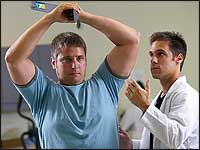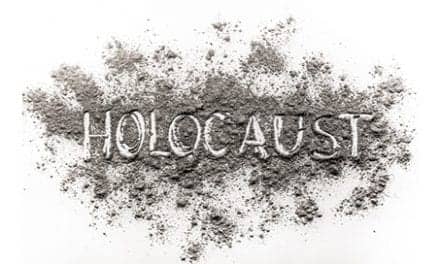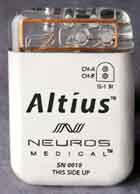 |
The shoulder is a fascinating part of the human body. It is one of the few anatomical areas that has the liberty to move in many directions, yet provides stability and strength. The amount of flexibility in a person’s shoulder is astounding. This flexibility allows people to reach high into a cupboard for the peanut butter jar, throw a 98 mph fastball in a baseball game, and reach around to scratch the ever so annoying itch on their back (that is, if they can reach that far).
While the benefits of the shoulder’s flexibility are numerous, disadvantages lurk: instability and a higher incidence of being prone to injury. Whether arthritis, ligamentous laxity caused by an unforeseeable fall, repetitive strains, or a sports-related injury plagues a person, the shoulder is a big target for injury. There is no safe haven from injury; accidents happen. Fortunately, there are specially trained physical therapists and quality rehabilitation programs that can help heal an ailing shoulder. These therapists and programs also offer many preventive steps to maintain a healthy shoulder and avoid further injuries or future reoccurrences.
COMMON SHOULDER INJURIES
To understand the shoulder and, more specifically, the healing and rehabilitation process, it is necessary to know the most common injuries or conditions. Some very common shoulder conditions include rotator cuff tendinitis, rotator cuff tear, impingement of the rotator cuff, bicipital tendinitis or tendinosis, adhesive capsulitis/frozen shoulder, and arthritis.
In many cases, shoulder pain can be the result of damage inflicted on the rotator cuff—a set of muscles leading into tendons that secure the arm to the shoulder bones and allow for movement and stability of the arm. When the rotator cuff muscles are not working properly, are weak, or are overworked, they can become “pinched” between the shoulder bones. Sometimes, this occurs if an occupation or gym workout includes frequent lifting in a forward, rotated position. If this is chronic, it can lead to swelling, pain, and perhaps a tear in the rotator cuff.
A tear in the rotator cuff may be minor (small) or major (large). Minor tears may be managed conservatively; however, if a severe tear occurs, surgery is usually required. Athletes are highly prone to rotator cuff tears.
Another common injury is multidirectional instability of the shoulder. When the capsule or ligaments that surround and support the shoulder stretch, joint laxity (looseness) occurs and the shoulder becomes unstable. This will require the muscles to overwork to support and stabilize the shoulder for activities. If they are unable to fully stabilize the bones, they move incorrectly and can impinge the rotator cuff, causing inflammation, pain, and rotator cuff tears. This common sports injury affects many swimmers and baseball pitchers. If not treated or taken care of, it can lead to a severe rotator cuff injury down the road.
EVALUATION: A MANDATORY STEP BEFORE REHAB
Evaluation is a crucial step when a patient enters the rehab stage. Potential rehab candidates may be first evaluated by their family physician or a specialist. Physical therapists complete a comprehensive examination and develop an individualized rehabilitation regimen. “Detailed examinations and individual rehab program development for each patient are very important,” says Tom Zeiser, PT, MS, of Good Shepherd’s orthopedic program. “Although two people share the same injury and each examination takes into account all factors, including their strength and motion, each program is customized to address the patient’s daily functional needs, including sports and work.”
When physical therapists first examine patients with a shoulder injury, they observe both posture and the shoulder position as it performs activities, shoulder range of motion, sensation, reflexes, strength of the key muscle groups, and how the affected muscle groups work together. Other key areas include the cervical spine examination and core strength. Generally, physical therapists assess patients by hand, and often use the most basic joint measurement tool known as the goniometer. Manual muscle testing is used to measure strength of specific muscles and to detect weak muscles.
Physical therapists also monitor patients performing functional activities such as reaching, pushing, pulling, tying shoes, and buttoning shirts. They want to gain knowledge of how a patient’s routine life is affected by the injury. Once this evaluation is complete, patients are ready to begin a comprehensive program designed by their physical therapists that addresses all their needs.
THE REHABILITATION PROCESS: AN INDIVIDUALIZED APPROACH
In the rehabilitation process, the emphasis is on the development of an individual and comprehensive program for shoulder injury patients. Physical therapists focus the rehabilitation program on four main points: developing (if not already developed) and maintaining good posture and flexibility, scapular stabilizing exercises, strengthening the rotator cuff and other key shoulder muscles, and instructions for a home program. Patients are instructed in the importance of good posture with all activities. Physical therapists teach them how to sit and stand properly, avoid repeated impingement positioning, and correct body mechanics when performing work and hobbies. Patients learn that bad posture, usually slumping, leads to impingement and abnormal tightening or stretching of some muscles, and can lead to a higher incidence of injury and pain. “Postural education is one of the first areas we cover in rehabilitation,” says Zeiser. “Patients need to understand that poor posture can lead to or contribute to shoulder pain and dysfunction. Learning good posture early on prevents problems later in life.”
 |
| Physical therapist Tom Zeiser monitors his patient’s reciprocal shoulder movements as he oscillates a therapy device designed to strengthen shoulder and core stabilizing muscles. |
Physical therapists instruct the patient in nonpainful exercises that improve the strength of the shoulder stabilizers including the rotator cuff. Along with many other basic exercises, one key exercise begins with the therapist placing the patient’s arm in nonpainful positions, asking the patient to hold it in place. The therapist adds manual resistance as the patient’s muscles hold the arm still. As patients progress, they move onto more advanced stabilization exercises with the arm in motion, using such equipment as a trampoline that returns a thrown weighted ball to the patient. Other equipment includes a patented, one-and-a-half pound flexible foil ranging from two and a half to five feet long, with a handgrip in the middle; patients use reciprocal shoulder movements to oscillate the blade to isolate and strengthen shoulder and core stabilizing muscles.
Other stages of rehabilitation include stretching tight muscles and joint structures, mobilizing joints, and general conditioning for endurance. For joint mobilization, physical therapists use their hands to stretch tightened shoulder structures such as the joint capsule and/or ligaments. They oscillate the bones slowly through the available range and may move the bones to the end of the range to help the stretch. As part of the endurance conditioning stage, a standing arm bike is frequently used. Patients can comfortably use the machine, which is adjustable for height, for warming up and endurance programs.
The duration or length of therapy programs varies. Rehab for some shoulder injuries may require only a few visits and include instructions and a customized home program. For other patients, therapy may last many months, depending on the severity of the condition or if the patient underwent surgery and is restricted by the healing tissues. If a patient has suffered a massive rotator cuff tear and has undergone a surgical repair, therapy can last 3 to 4 months for full recuperation. It is desirable that each patient achieve their full rehab potential at the time of discharge. This includes full motion and strength, minimal to no pain, and a return to previous activities such as hobbies and work.
AT-HOME PROGRAM
The ultimate goal for all patients is to return to normal activities once they are discharged from physical therapy. Although patients receive postural education and information and perform strengthening, conditioning, and stretching exercises during therapy, therapists also provide exercises for patients to continue at home. Because they cannot be with their patients 24 hours a day, therapists begin developing an at-home program as soon as a patient’s physical therapy begins. If needed, family members may be recruited to assist even if it is just for encouragement. Patients may be provided with rubber tubing to use for home strengthening. They receive pictures of stretches and exercises and are instructed on how frequently they are to complete their home program.
Patients are educated on how to take care of themselves and prevent reoccurrence of injury. They learn to recognize signs and symptoms of reoccurrence and are persuaded to never slack off from their workouts. They should do only exercises with which they are familiar to prevent injury unless they seek advice from a knowledgeable health professional. They are urged to continue the strengthening exercises for the length of time their physical therapists prescribe. Some patients will be able to discontinue specific exercises but be cognizant of preventing reoccurrence.
As vulnerable as the shoulder may be for injury to occur, people have the opportunity to recover significantly, if not fully, with physical therapy treatment and programs. With the right amount of dedication, and a high level of commitment to rehab and the performance of their recommended program, most people can return to a life similar to what they had prior to injury.
Cynthia Bauer, PT, DPT, OCS, is regional manager of outpatient services at Good Shepherd Rehabilitation Network, Allentown, Pa.





